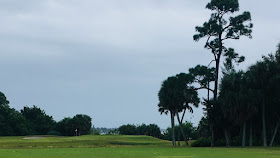(The 400/369 yard par four eighteenth is fronted by wetlands with a view of the Port St Lucie River behind the green. It’s an exact approach shot with little room to bail out. Into the wind, this brute plays very difficult.)
The River Club was designed in 1992 and renovated in 2006 by Jack Nicklaus. The renovation involved landscaping, bulkheading the lakes, and regrassing the tees fairways and greens. Visually the course beautiful. It’s presented very well and is in great condition.
(The 185/173 yard par three fourteenth is played over a waste area to a green set at a diagonal. Several engaging pin placements, including the front pin in the picture, makes a par a well deserved score.)
This is my third Nicklaus course, and every single one plays hard. I’m not a fan of his architecture. They’re overly penal in my opinion. Many of the greens have small sections to them, and it’s imperative to be in that section to have a chance at birdie or to make a par. Between the water, sand, and the slope, missing the green results in a difficult recovery shot. Hitting the green but on the wrong section usually results in a three putt. For class A players, it’s a strong test, but for average players it’s not fun. My friend who lives down here commented that the last time he played here, he didn’t turn in a card because he couldn’t finish some of the holes.
(The 196/175 yard par three seventeenth. The pin is in the front left corner. The only shot that holds to this spot is high cut. 32 men and not one person hit the green. From the right bunker to the pin is downhill, so a draw leaks off the front.)
(This pic shows just how small the pinning area can be. There’s not much room to get the ball below the hole. Most players were coming from the fringe or rough behind, and lagging to the pin.)
(This pic shows just how small the pinning area can be. There’s not much room to get the ball below the hole. Most players were coming from the fringe or rough behind, and lagging to the pin.)
Most of the holes here at the River Club revolve around water. They’re constantly doglegging left or right and the golfer is picking when to be aggressive or laying back. The aggressive play is almost always rewarded. It results in a better angle, shorter iron, and more options to get at the pin. The weaker player is punished for not taking on the challenge by being forced to hit a much tougher approach shot.
(The 345/338 yard par four eighth illustrates the bias towards the long hitter. This is the view for a long drive over the left fairway bunker. As one can see, the green slopes to the water, so the player can hit a wedge left of the flag and spin it close. The short player comes in further right, so his approach is all carry. While there is a backstop, chances are an extra club is used and he’ll be looking at a devilish putt down the slope.)
(The 345/338 yard par four eighth illustrates the bias towards the long hitter. This is the view for a long drive over the left fairway bunker. As one can see, the green slopes to the water, so the player can hit a wedge left of the flag and spin it close. The short player comes in further right, so his approach is all carry. While there is a backstop, chances are an extra club is used and he’ll be looking at a devilish putt down the slope.)
(The 549/486 yard par five second can be reached in two but the second shot best be perfect to find this green. The right greenside bunker has a shoulder that pitches the ball towards the water. For the player laying up in right side of the fairway, a delicate pitch is required to get close. The water eats into the green so the rear left portion is very dicey.)
The River Club played quite difficult the day we were there, so I really wonder how good or bad the course plays on a daily basis. The river is obviously very close so I reckon it’s windy more times than not. If one loves very difficult courses than this place will suit you fine. I give it a 5 (good)(worth driving an hour). It is private so worth an invitation.
















